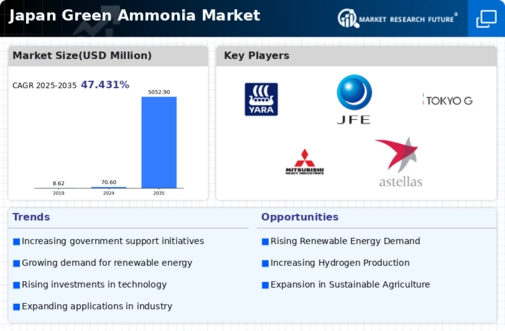The competitive landscape of the Japan Green Ammonia Market is rapidly evolving, driven by the increasing emphasis on sustainable energy solutions and the decarbonization efforts across various sectors. As countries strive to meet their carbon neutrality goals, Japan has recognized green ammonia as a crucial component of its future energy strategy. The market is characterized by a mix of established players and emerging innovators, all aimed at developing efficient production methods, distribution networks, and applications for green ammonia.
This sector is not only crucial for hydrogen production but also represents a significant opportunity for integration into existing ammonia markets, thereby creating synergies with current industrial processes. The intense focus on renewable energy sources, combined with government initiatives and investments, is setting the stage for robust competition as companies vie for leadership and market share in this promising industry.ENEOS Corporation has distinguished itself as a strong player in the Japan Green Ammonia Market with significant investments in sustainable technologies.
The company has been proactive in diversifying its energy portfolio, focusing on the development and commercialization of green ammonia production processes. ENEOS encompasses an array of strengths, including its extensive operational experience in the energy sector, a well-established supply chain, and partnerships with academia and technology firms aimed at advancing green technology. This positioning allows ENEOS Corporation to leverage its existing infrastructure while facilitating the transition towards more sustainable ammonia solutions.
The company’s commitment to innovation and environmental responsibility further enhances its competitive edge, making it a key contender in shaping the future landscape of green ammonia in Japan.Chiyoda Corporation also plays a pivotal role in the Japan Green Ammonia Market, focusing on its advanced capacity for innovative engineering solutions. The company's expertise lies in its proprietary technology that facilitates efficient ammonia synthesis and handling, making it an essential player in this field. Chiyoda Corporation provides key services that include ammonia production technology, storage solutions, and logistical frameworks tailored to green ammonia applications, thereby reinforcing its market presence.
Their strategic partnerships and collaborations with various stakeholders, including governmental bodies and research institutions, support the development and implementation of green ammonia initiatives in Japan. Additionally, the company has demonstrated growth through various mergers and acquisitions, enhancing its technological capabilities and expanding its operational footprint in the green ammonia space. With a robust portfolio of services and a commitment to sustainability, Chiyoda Corporation remains well-positioned to influence the evolution of the green ammonia market in Japan.
















Leave a Comment